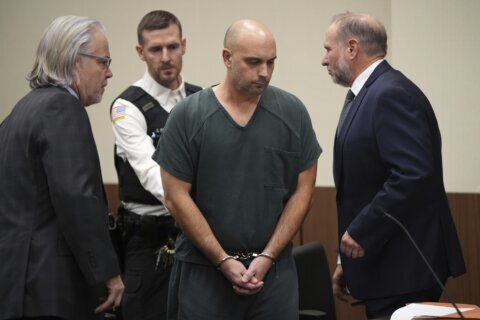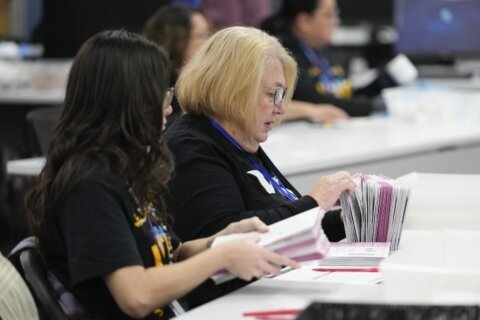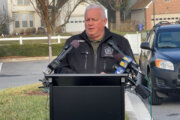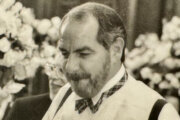NEW YORK (AP) — There are, as a rule, only so many places you can go as an action movie after leaving Tom Cruise clinging to the side of an Airbus A400M and flinging him out a cargo plane at 25,000 feet.
But in the kinetic, headlong world of “Mission: Impossible,” the pressure to keep upping the ante — like the films’ always-running star — never stops.
“Every time we finish a movie, the first thing Tom says to me is: We can do better,” says Christopher McQuarrie.
McQuarrie, the writer-director of 2015’s “Mission: Impossible – Rogue Nation” and the 2018 franchise high point, “Mission: Impossible – Fallout,” was working with Cruise on “Top Gun: Maverick ” (which McQuarrie co-wrote and co-produced) when they started talking about their ambitions for the next iteration of “Mission: Impossible.”
Their plan was to make not one but two sequels: Back-to-back blockbusters that would feature even bigger stunts — Cruise envisioned a motorcycle jump-slash-skydive — and a massive train sequence that McQuarrie pined to realize. The heady experience on “Maverick,” a pop-culture juggernaut that grossed nearly $1.5 billion worldwide, only further ratcheted up their aspirations.
“‘Top Gun: Maverick’ really taught us a lot in terms of character dynamics and the emotional payoff of the movie overall,” McQuarrie said in a recent interview. “To be making movies on this scale, you really need to think about, more than anything, the feeling that the audience is left with going away.”
A year after the box-office dominance of “Maverick”, McQuarrie and Cruise are back with another high-flying spectacle of daring-do. Similar to “Maverick,” “Mission: Impossible – Dead Reckoning Part One” is a state-of-the-art action extravaganza of old-school technique, made with star power, practical effects and stunt work designed to prompt exclamations of “He did what?”
It was also their most nearly impossible mission yet – and not just because of, according to Paramount Pictures, the 500 skydives and 13,000 motocross jumps that Cruise did in preparation for his climactic stunt. “Dead Reckoning” was just days away from beginning production in Venice when COVID-19 cases began skyrocketing in Italy, an early epicenter.
“Mission: Impossible” was one of the first major productions to be shut down by the pandemic. Months later, Cruise and “Dead Reckoning” – a globe-trotting $290 million movie so logistically complicated that it prompted controversy for initial plans to blow up a century-old bridge in Poland – led an industry-wide effort to get movie business back on line during the pandemic. An already high-stress production became even more tense. In December 2020, an audio recording leaked of Cruise yelling at two crew members for not obeying COVID-19 protocols.
“We are the gold standard,” Cruise said in the recording. “They’re back there in Hollywood making movies right now because of us. Because they believe in us and what we’re doing.”
There were numerous delays and pivots along the way. But McQuarrie says he never thought “Dead Reckoning” wouldn’t get finished.
“We just kept moving forward because if you stopped, if you were trying to find the end of the tunnel, you would just reach a place of such despair,” says McQuarrie.
McQuarrie and Cruise first collaborated on the 2008 Hitler assassination drama “Valkyrie.” McQuarrie, the famed screenwriter of “The Usual Suspects,” was then in proverbial movie jail for his poorly received directorial debut, “The Way of the Gun.”
“When I met Tom in 2006, I had not directed a film in seven years,” McQuarrie says. “I wouldn’t direct a film again for another five years. I had really put any ambitions I had to direct out of my mind. I certainly never imagined being considered an action director, let alone directing four action films.”
“In ‘Dead Reckoning,’ you’re seeing the ghosts of all the movies that I was never allowed to make,” he adds.
Unlikely as it may be, McQuarrie (who’s also directing the already-shooting part two of “Dead Reckoning”) has emerged as the architect of one of the most visceral action franchises.
In “Dead Reckoning,” Ethan Hunt faces off with a rogue artificial intelligence, a prescient and well-suited antagonist for a movie universe built less on CGI than practical effects. McQuarrie told Cruise he wanted to wanted to take “Mission: Impossible” beyond the threat of a terrorist getting hold of a deadly weapon.
“Another lesson we took from ‘Top Gun’ was: What is the audience bringing to the movie? ‘Top Gun’ came out of Cold War anxieties. I said to Tom in 2019: What anxiety is it now?” says McQuarrie. “What we didn’t anticipate was the level to which it would accelerate.”
In “Mission: Impossible,” what you see is rarely what you get. Hunt and his team of spies are masters of deception. At the same time, McQuarrie and his crew, including cinematographer Fraser Taggart, go to considerable lengths to ensure what the audience is watching feels authentic and immersive.
“The challenge normally is hiding the fact that it’s not the actor doing it,” says McQuarrie. “And here the reverse is the case. You’re actually going to great lengths to show that Tom’s actually doing it.”
Taggart, who had shot the helicopter sequence in “Fallout,” says he’s never worked with an actor so resistant to stunt doubles as Cruise — even in the most innocuous of shots.
“Tom won’t do it. He just refuses, even to the extent of you’ll do an insert of hand,” says Taggart. “It can’t be anyone else doing it, as you would on other projects. Tom will insist that’s him.”
Just as “Top Gun: Maverick” strove to get as many cameras in the cockpits of fighter jets, the set-pieces of “Mission: Impossible” are choreographed to get cameras as close to Cruise and the cast — here that includes Hayley Atwell, Rebecca Ferguson and Vanessa Kirby — as possible.
For Taggart, that meant getting his head around often dizzying challenges like shooting a scene involving a train moving 60 miles an hour through a mountainous Scandinavian landscape with uncontrollable weather conditions. He didn’t want just fixed cameras.
“So now we’ve got to get a whole camera crew involved and some lighting and we’ll probably end up with 10 people strapped to the top of a train carriage, including an old-fashioned physical camera up there,” says Taggart. “You think: Can we actually get 10 people on top of the train doing 60 miles an hour? That’s the challenge because you’d really like all of your crew and actors to survive the shoot.”
In another sequence with characters inside a falling train cabin, they suspended a camera operator, Chunky Richmond, on stunt wires so he was hanging alongside the actors. For a nighttime chase through the byzantine passageways of Venice — for Taggart one of the most complex tasks of “Dead Reckoning” because of the inherent darkness of the city — they knocked on doors everywhere along the route to get cameras on terraces and pointed out windows.
For an elaborate car chase in Rome, Taggart used robotic arms on vehicles that were mounted but could also move.
“We always try technology but we usually break it all,” he says.
McQuarrie has said he likes to write “Mission: Impossible” movies as they’re shooting; “Fallout” began without just an outline. Production on “Part Two” has been paused during the promotion on “Part One,” and it’s unclear if the ongoing writers strike would threaten production on the sequel. But for McQuarrie and company, the only way to make a “Mission: Impossible” movie is full tilt.
“Everything we’re doing is by the seat of our pants,” says McQuarrie. “We want you to come to the movie and experience it the same way the characters are, which is: I don’t know what’s going to happen next.”
___
Follow AP Film Writer Jake Coyle on Twitter at: http://twitter.com/jakecoyleAP
Copyright © 2024 The Associated Press. All rights reserved. This material may not be published, broadcast, written or redistributed.







